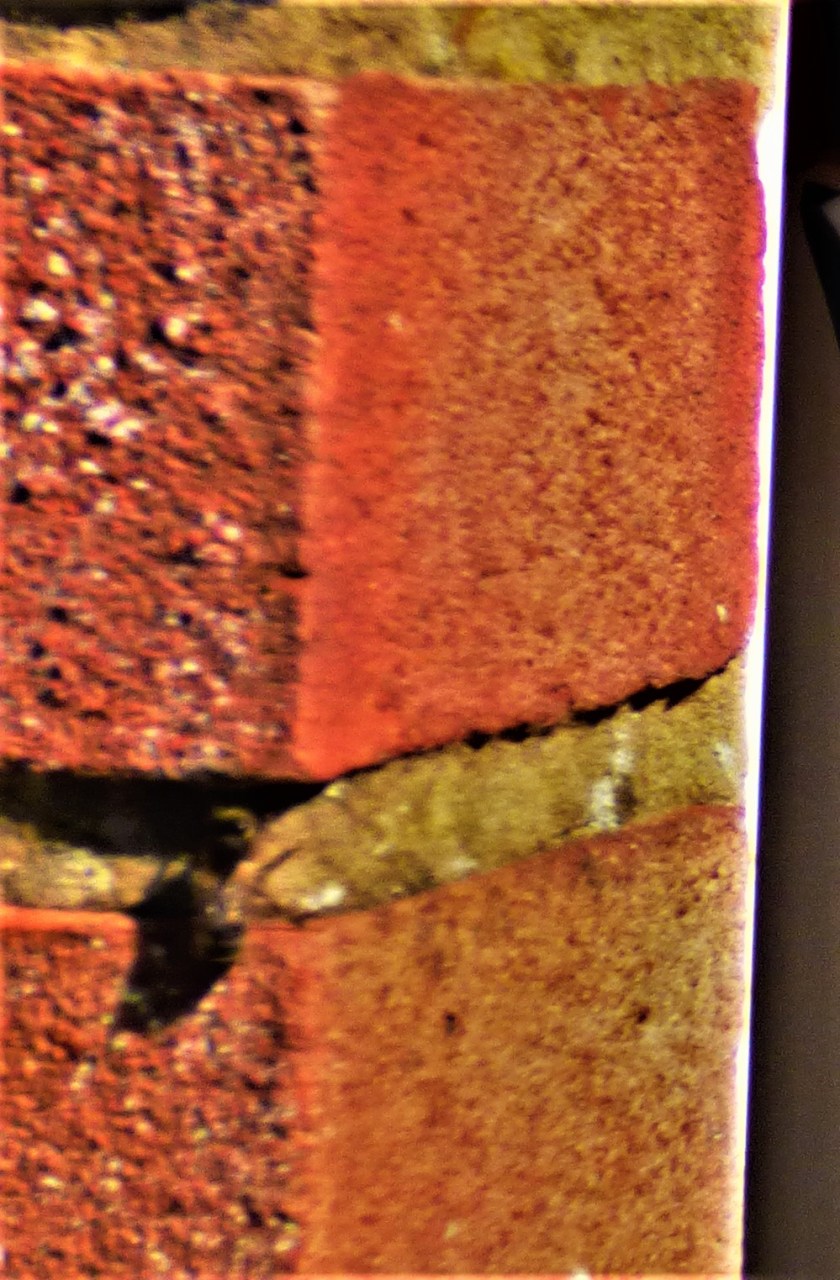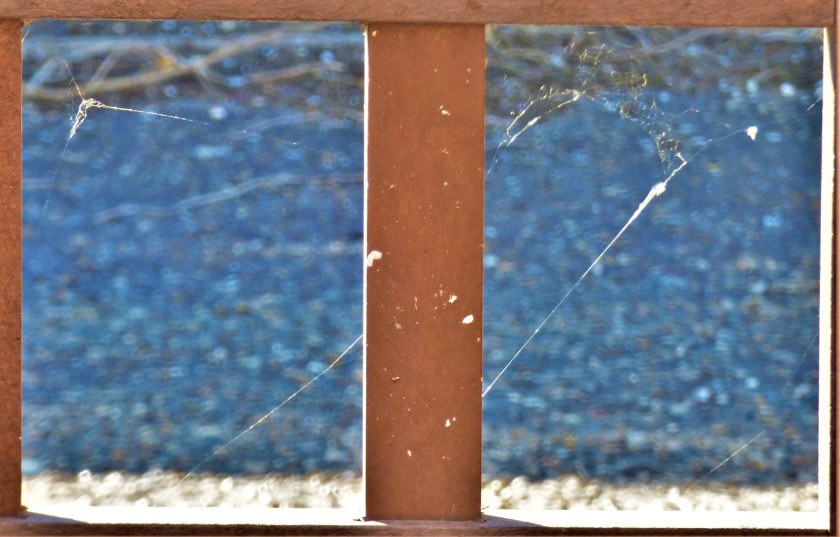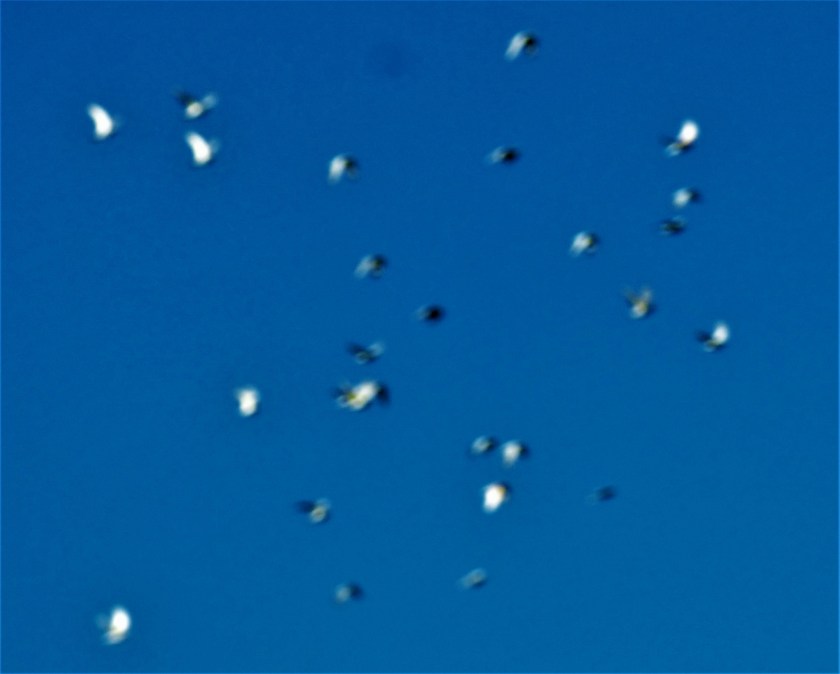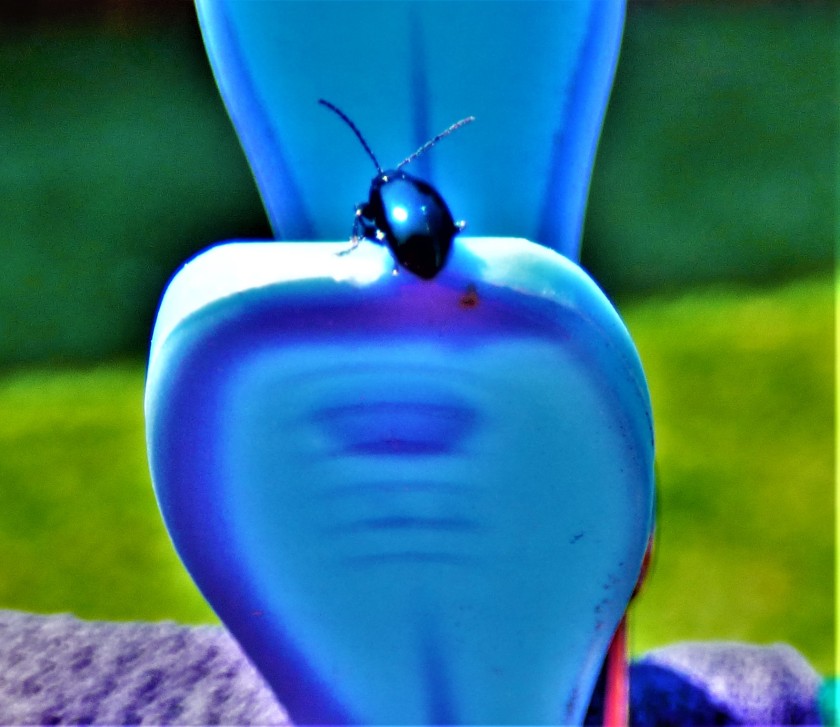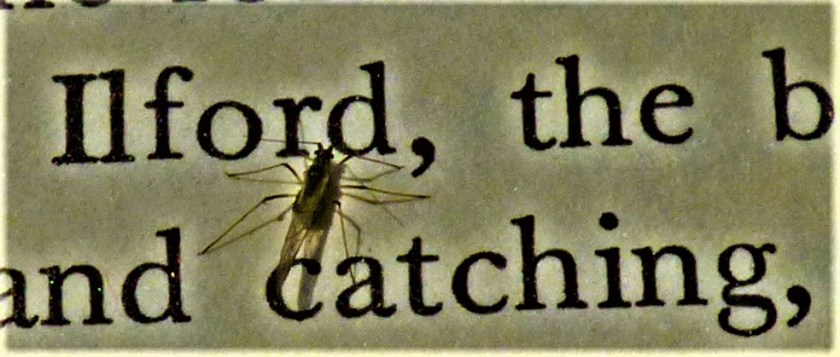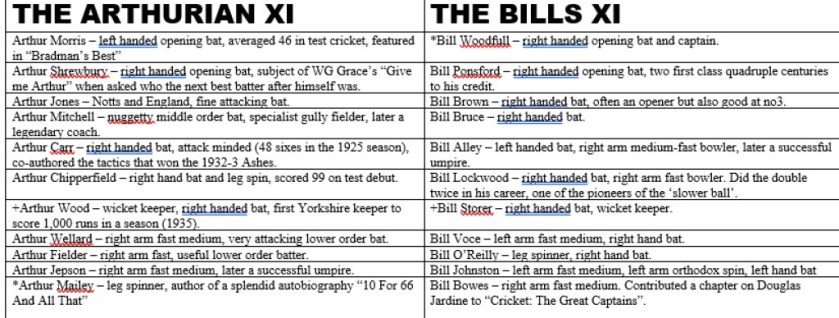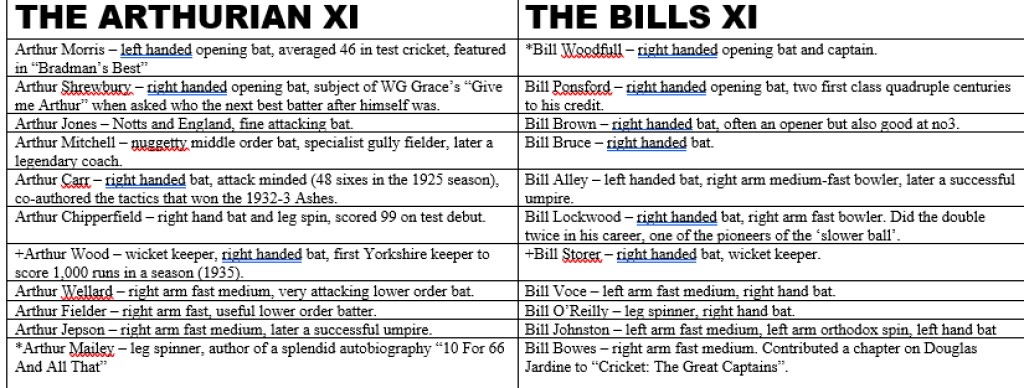INTRODUCTION
Welcome to my latest take on the ‘All Time XI‘ theme that I am exploring while ‘Pandemic Stops Play’ remains the case. Today we look at two teams of players whose common factor is their given name.
THE BRIEF
The Arthurians, a team moniker plucked from the realms of mythology (knights of the round table etc), all have the given name Arthur. The Bills, a team moniker borrowed from an outfit based in Buffalo, NY each have the given name Bill. I stuck resolutely to the given name theme, ignoring players surnamed Arthur and Australian batter Wendell Bill. I also ignored nicknames, so no ‘Bill Fender’ or (Graeme Swann has the “credit” for this one) Tammy ‘BIll’ Beaumont. Also I stuck rigidly to Bills, no mere Billies allowed, sadly for Barnes and Gunn of Nottinghamshire, Bates of Yorkshire, Murdoch of Australia and Sussex or Messrs. Godleman (Middlesex, Derbyshire) and Taylor (Hampshire) of more recent vintage. Similarly, for readers of my most recent post, ‘Silver Billy’ Beldham had to be disqualified. I also stuck resolutely to the ‘team’ principle – no crowbarring players in out of position here. Ground rules laid out it is time to meet the teams, starting with…
THE ARTHURIANS
- Arthur Morris – left handed opening bat, flourished immediately post World War II. He is one of relatively few players to have had a seriously big score overshadowed by someone else scoring a blob in the same innings. It occurred at The Oval in 1948, when Don Bradman was bowled second ball by Eric Hollies ot be left with a test average of 99.94. Morris batted through the Aussie innings on that occasion, leading to the following oft repeated snatch of conversation:
questioner: did you see Bradman’s last test innings? Morris: “Yes, I was batting at the other end” questioner: “how many did you get” Morris, deadpan: “196” - Arthur Shrewsbury – right handed opening bat, famously rated by WG Grace as second only tp himself.
- Arthur Jones – regular number three for Notts and England in his day. He lalso bowled leg spin.
- Arthur Mitchell – vital part of Yorkshire’s top or middle order in the 1930s, specialist gully fielder who turned himself into one of the best around in that position. When his playing days were done he became a hugely successful coach. Harold ‘Dickie’ Bird and Michael Parkinson (later famous as writer and broadcaster), then opening partners for Barnsley in league cricket were summoned to the Yorkshire nets when he was coach, Parkinson got Maurice Leyland’s net, enjoyed himself but did not get invited back, while Bird got Mitchell’s net, was reduced by the stern “Ticker” to a quivering wreck, but did enough right to be asked back (the story appears in “Parkinson on Cricket”, by the aforementioned Michael Parkinson).
- Arthur Carr – Nottinghamshire middle order bat, inclined to attack (he hit 48 sixes in the 1925 season) and a shrewd tactician. He helped Jardine with his tactics for the 1932-3 Ashes Tour (he was county captain to two of the key bowlers). It was also Carr who confirmed to Jardine that Larwood and Voce were accurate enough to bowl to a 7-2 field. Incidentally, the two injuries sustained by Aussie batters in taht series both happened while Larwood was bowling to an offside field, and one of them, Oldfield’s, was admitted by the victim to be his own fault – he took on the hook shot and edged the ball into his own head.
- Arthur Chipperfield – right hand bat and leg spinner. He still has a place in the record books as the only amle to score 99 on test debut (it was a lunch interval that did for him – he was out second ball on the resumption, while Jess Jonassen an Aussie of more recent vintage hit 99 in her first test innings). Chipperfield did eventually manage a test century, a feat that Ms Jonassen has yet to accomplish, though she has time to do so.
- +Arthur Wood – wicket keeper and right handed lower middle order bat. In 1935 he became the first Yorkshire keeper to score over 1,000 runs in a season. In 1938 he made his test debut at the Oval, and walked out following Hutton’s dismissal for 364, with the score reading 770-6 and is alleged to have announced his presence in the middle by saying “Always wor a good man for a crisis, me”. No Aussie responses to this have been recorded. He rattled up 53 in that debut innings, being out with the score on 879. Another Yorkshireman, Verity, followed him to the crease and was with Joe Hardstaff, when the 900 came up, and Hammond having had confirmation that Bradman would not be batting finally declared, to the relief of all save Oval groundsman ‘Bosser’ Martin who had wanted to see a score of 1,000 achieved on his pitch.
- Arthur Wellard – right arm fast medium bowler, very attacking right handed lower order batter. In all he smote 500 first class sixes, 66 of them in 1935 alone, which stood as a season’s record for 50 years, before Ian Botham wellied 80 maximums in just 27 innings. Like Botham, Wellard played for Somerset, and he appears to have been every bit as inclined to deposit balls in the river Tone. In a match against Nottinhamshire he featured in a ‘gotcha’ sequence – when Notts batted a certain H Larwood was out B Wellard 0, while the corresponding line in the Somerset scoresheet read AW Wellard B Larwood 0.
- Arthur Fielder – right arm fast bowler, right handed lower order bat.
- Arthur Jepson – right arm fast medium, right handed lower order bat.After his playing days were done he became an umpire, and in that capacity was responsible for one of the great refusals of an appeal against the light. It was a limited overs match, and the time was closer to 9PM than 8, and when the issue of light was raised Jepson pointed to the sky and said “You can see the moon, how far do you need to be able to see?”
- *Arthur Mailey – leg spinner, no 11 batter. Until Rodney Hogg surpassed it in 1978-9 he held the record for wickets by an Aussie in an Ashes series, with 36 of them in 1920-1. In a tour match against Gloucestershire he dismissed the county by himself, recording innings figures of 10-66, which gave him the title for his autobiography “10 For 66 And All That” – and it is a splendid read. When Victoria put up their all time record first class team total of 1,107 (Ponsford 352, Ryder 295, Woodfull 133, Hendry 100, FL Morton run out for 0 amidst the carnage) Mailey took 4-362, still the most runs conceded by a bowler in a first class innings, although for me the 1-298 recorded by ‘Chuck’ Fleetwood-Smith in the Oval test match of 1938 is a worse shocker, because at least Mailey was getting wickets. Mailey himself claimed to have regretted that Jack Ellis, the last Victorian dismissed, had run himself out “just as I was striking a length” and also pointed out that “a chap in the shilling stand dropped an easy chance from Jack Ryder early in his innings”. In 1930 the manager of the Australian tour party upbraided him for passing on bowling tips to Scottish born leg spinner Ian Peebles and Mailey produced the classic response: “Spin bowling is an art and art is international.” Well spoken, Mr Mailey.
That is the Arthurian cast in all its glory, so now it is time to meet…
THE BILLS
- *Bill Woodfull – prolific opener for Victoria and Australia, twice regained the Ashes as Captain on his birthday (1930 and 1934). He was known in his day as ‘the unbowlable’, and did once go two entire seasons without being dismissed by that method.
- Bill Ponsford – regular opening partner of Woodfull for Victoria and Australia, scorer of two first class quadruple centuries.
- Bill Brown – right handed top order batter, usually an opener but could also go in at three, where I have put him in this team.
- Bill Bruce – attacking top order bat for Australia in the 1890s.
- Bill Alley – left handed bat, right arm medium fast. Became an umpire once his playing days were down.
- Bill Lockwood – right arm fast, right handed bat. Played for Nottinghamshire, Surrey and England. He was among the first fast bowlers to become noted for bowling a ‘slower ball’, and it would seem that not until Franklyn Stephenson, approximately 90 years later did anyone else wreak quite such havoc with that type of delivery. He achieved the double of 1,000 runs and 100 wickets in a seaosn twice
- +Bill Storer – wicketkeeper and combative right handed bat. The Derbyshire man toured Australia in 1897-8. In 1904 it was he who partnered Charles Ollivierre in the match winning second wicket stand at Chesterfield, when Derbyshire set 149 in 125 minutes knocked them off easily. Ollivierre and Storer were each also eyeing up personal landmarks – Ollivierre a century to go with his double in the first innings and Storer a fifty, and neither got there – Ollivierre 92 not out, Storer 48 not out. Storer was one of the players involved in the ‘netting boundary’ scheme trialled briefly in the late 1890s: netting 2-3 feet high was erected around the boundary, and batters got three for shots clearing the netting and two plus any they had managed to run if the ball rolled into the netting. This scheme, intended to discourage slogging and encourage gentle ground strokes made snicks through the slips very remunerative indeed. Storer did produce a score of 175 under this scheme, while in that same innings Wood was credited with 10 off a delivery from Cuthbert Burnup. The scheme was abandoned pretty swiftly however. Andrew Ward covers it in “Cricket’s Strangest Matches”.
- Bill Voce – left arm fast medium bowler, right handed batter. Toured Australia three times, successfully in 1932-3, as part of a narrowly beaten side in 1936-7 and in the ‘goodwill tour’ of 1946-7 where Bradman did not get the memo and an ill-equipped England were utterly routed. Cliff Cary, an Australian who commentated during that series, also wrote a book length account of it, “Cricket Controversy”.
- Bill O’Reilly – leg spinner, greatest bowler of the inter-war years and excellent writer (e.g “Cricket Taskforce”, his book about the 1950-1 Ashes).
- Bill Johnston – left arm fast medium, left arm orthodox spin, tail end batter. He was Australia’s leading wicket taker in the 1946-7, 1948 and 1950-1 Ashes series, and although hampered by an injury on the 1953 tour he became only the second after Bradman to average 100 for an English season (102 runs at 102.00, courtesy of 16 red inkers in 17 innings, some of them gained with the active connivance of team mates who saw the amusement value in him claiming a batting record). In the 1954-5 series, his last outing, he helped Neil Harvey to add 39 for the last wicket on the second test match, but too much damage had already been done, and England eventually got that last wicket to level the series at 1-1 (Harvey 92 not out), a position from which Hutton’s team never looked back.
- Bill Bowes – right arm fast medium, genuine no11 batter. His county, Yorkshire, were champions seven times in the 1930s, and in that decade he was only once outside the top 10 of the national bowling averages. His test opportunities were limited, but 68 wickets at 22 from 15 appearances does not exactly betoken failure at that level. In retirement he became an entertaining writer – he contributed the chapter on Jardine to “Cricket: The Great Captains”.
That is the Bills introduced, and we move on to:
AN EVALUATION
The Arthurians have a nicely contrasted opening pair, a useful look 3-5, an all rounder, a wicket keeper who can bat, three pace bowlers of varying types and a quality leg spinner. They are short in the finger spin department, but apart from that the look a pretty good unit.
The Bills have a solid opening partnership, nos 3,4 and 5 look pretty useful, they have a genuine all rounder at six, a good wicket keeper and combative bat at seven, and four widely varied bowlers to round out the XI. They are also a little short finger spin wise, but Johnston could bowl that, and Voce occasionally deployed it to.
I would expect a close and entertaining contest for the trophy (provisional name, given the presence of the Arthurians, The Grail!). One final section:
HONOURABLE MENTIONS
Arthur Morton of Derbyshire only just missed out for the Arthurians, while there were also two other possible wicket keepers for them, another Yorkshireman, Arthur Dolphin and Gloucestershire keeper and WG Grace’s best man, Arthur Bush. The Bills, even with my tight restrictions had a surplus of top order riches – Bill Lawry missed out on an opening slot, while Bill Hitch was unlucky among the bowlers, and Bill Edrich would also have his advocates. Bill Andrews of Somerset was another who merited consideration for his bowling. Bill Athey could not be accommodated in a side that had two renowned stickers opening the batting.
PHOTOGRAPHS
My chosen combatants for the ‘Grail Trophy’ have been introduced, along with a few potential replacements, and all that now remains to apply my usual sign off…

